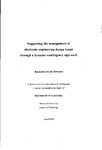Supporting the management of electronic engineering design teams through a dynamic contingency approach
| dc.contributor.author | Parsons, Richard David | |
| dc.contributor.other | School of Engineering, Computing and Mathematics | en_US |
| dc.date.accessioned | 2013-11-07T13:35:37Z | |
| dc.date.available | 2013-11-07T13:35:37Z | |
| dc.date.issued | 1998 | |
| dc.identifier | NOT AVAILABLE | en_US |
| dc.identifier.uri | http://hdl.handle.net/10026.1/2672 | |
| dc.description.abstract |
The contribution to knowledge presented in this thesis is the dynamic contingency approach, supported through software, which supports the management of the early, conceptual stages of electronic engineering team design. 1he term contingency pertains to the design environment being in a contingent state, that is "dependent on uncertain issues" (Hayward & Sparkes, 1991). These issues are typically dynamic, that is ''pertaining to forces not in equilibrium, forces that produce motion" (Hayward & Sparkes, 1991). The concept for the dynamic contingency approach was developed through a soft systems analysis. This analysis drew upon an ethnographic study conducted in parallel with the present work by another researcher. Both the present work and the ethnographic study were carried out within a multidisciplinary research team in collaboration with an industrial partner (company A). This thesis discusses the evolution of this multidisciplinary research method, including the development of a software prototype (EDAPT), which enabled the requirements for the dynamic contingency approach to be established. Through this research method key issues were identified which affect the ability of design managers, and to a lesser extent design engineers, to adequately perceive the current situation of a design project; and to determine appropriate corrective responses to potential problem situations. The work indicates that this is particularly true when under pressure in such a complex, interdependent and dynamic environment. This thesis illustrates how the environment of design can be dependent upon these key issues which are often uncertain, that is, the environment is in a contingent state. Furthermore, the thesis depicts the dynamic nature of these issues. The dynamic contingency approach was developed in response to these issues in partnership with the industrial collaborator. The approach synthesises a variety of such issues to support the coordination of interdependencies, provide a view of the current project situation, alert stakeholders to potential problem situations, and present possible responses to potential problem situations. In short, what has been achieved is a design management worldview with sufficient detail to help people expect and anticipate what might happen, and how others may behave in a team design environment, together with the foundations for a system which enables and supports this perspective. In essence the approach provides a way of conceptualising the design environment which should enable improvements in the management of design teams at the early, conceptual stages of electronic engineering design projects. | en_US |
| dc.language.iso | en | en_US |
| dc.publisher | University of Plymouth | en_US |
| dc.title | Supporting the management of electronic engineering design teams through a dynamic contingency approach | en_US |
| dc.type | Thesis | |
| plymouth.version | Full version | en_US |
| dc.identifier.doi | http://dx.doi.org/10.24382/4010 | |
| dc.identifier.doi | http://dx.doi.org/10.24382/4010 |
Files in this item
This item appears in the following Collection(s)
-
01 Research Theses Main Collection
Research Theses Main


